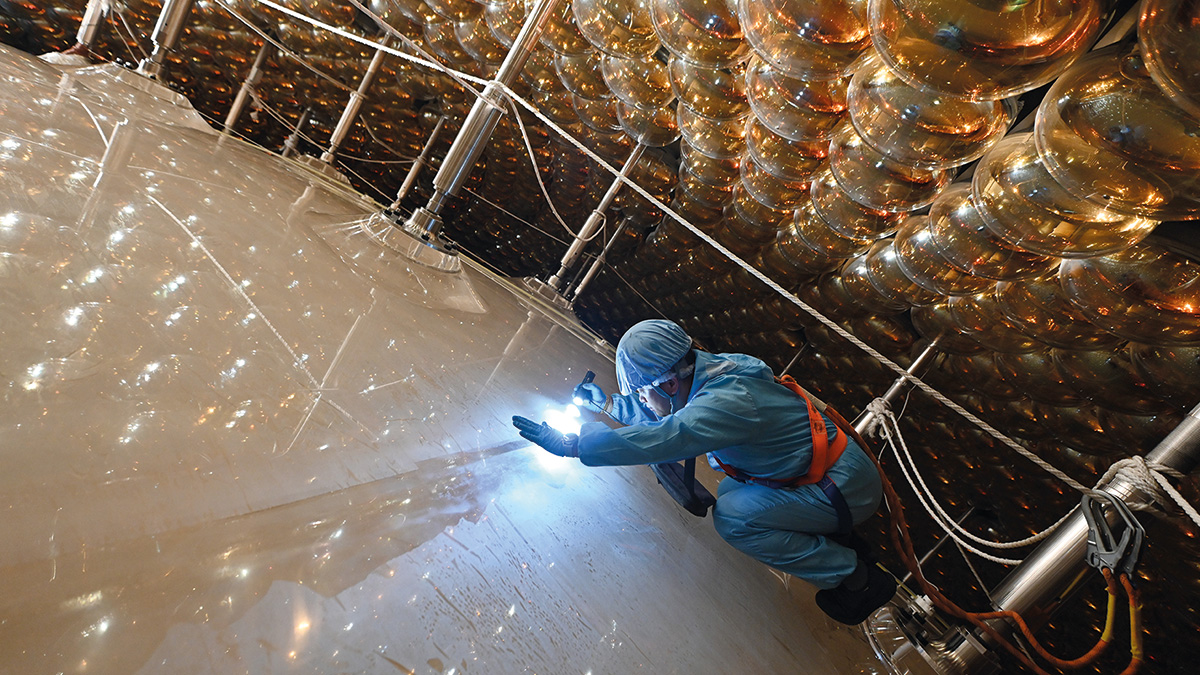Additional eye Encompassed by photomultiplier tubes, an engineer shines a light inside the acrylic sphere housing JUNO’s liquid-scintillator detector. Credit: JUNO Collab.
Compared to the quark sector, the lepton sector is the Wild West of the weak interaction, with large mixing angles and large uncertainties. To tame this wildness, neutrino physicists are set to bring a new generation of detectors online in the next five years, each roughly an order of magnitude larger than its predecessor. The first of these to become operational is the Jiangmen Underground Neutrino Observatory (JUNO) in Guangdong Province, China, which began data taking on 26 August. The new 20 kton liquid-scintillator detector will seek to resolve one of the major open questions in particle physics: whether the third neutrino-mass eigenstate (ν3) is heavier or lighter than the second (ν2).
“Building JUNO has been a journey of extraordinary challenges,” says JUNO chief engineer Ma Xiaoyan. “It demanded not only new ideas and technologies, but also years of careful planning, testing and perseverance. Meeting the stringent requirements of purity, stability and safety called for the dedication of hundreds of engineers and technicians. Their teamwork and integrity turned a bold design into a functioning detector, ready now to open a new window on the world of neutrinos.”
Main goals
Neutrinos interact only via the parity-violating weak interaction, providing direct evidence only for left-handed neutrinos. As a result, right-handed neutrinos are not part of the Standard Model (SM) of particle physics. As the SM explains fermion masses by a coupling of the Higgs field to a left-handed fermion and its right-handed counterpart of the same flavour, neutrinos are predicted to be massless – a prediction still consistent with every effort to directly measure a neutrino mass yet attempted. Yet decades of observations of the flavour oscillations of solar, atmospheric, reactor, accelerator and astrophysical neutrinos have provided incontrovertible indirect evidence that neutrinos must have tiny masses below the sensitivity of instruments to detect. Observations of quantum interference between flavour eigenstates – the electron, muon and tau neutrinos – indicate that there must be a small mass splitting between ν1 and the slightly more massive ν2, and a larger mass splitting to ν3. But it is not yet known whether the mass eigenvalues follow a so-called normal hierarchy, m1 < m2 < m3, or an inverted hierarchy, m3 < m1 < m2. Resolving this question is the main physics goal of the JUNO experiment.
JUNO’s determination of the mass ordering is largely free of parameter degeneracies
“Unlike other approaches, JUNO’s determination of the mass ordering does not rely on the scattering of neutrinos with atomic electrons in the Earth’s crust or the value of the leptonic CP phase, and hence is largely free of parameter degeneracies,” explains JUNO spokesperson Wang Yifang. “JUNO will also deliver order‑of‑magnitude improvements in the precision of several neutrino‑oscillation parameters and enable cutting‑edge studies of neutrinos from the Sun, supernovae, the atmosphere and the Earth. It will also open new windows to explore unknown physics, including searches for sterile neutrinos and proton decay.”
Located 700 m underground near Jiangmen city, JUNO detects antineutrinos produced 53 km away by the Taishan and Yangjiang nuclear power plants. At the heart of the detector is a liquid‑scintillator detector inside a 44 m-deep water pool. A stainless-steel truss supports an acrylic sphere housing the liquid scintillator, as well as 20,000 20‑inch photomultiplier tubes (PMTs), 25,600 three‑inch PMTs, front‑end electronics, cabling and anti‑magnetic compensation coils. All the PMTs operate simultaneously to capture scintillation light from neutrino interactions and convert it to electrical signals.
To distinguish the extremely fine flavour oscillations that will allow JUNO to observe the neutrino-mass hierarchy, the experiment must achieve an extremely fine energy resolution of almost 50 keV for a typical 3 MeV reactor antineutrino. To attain this, JUNO had to push performance margins in several areas relative to the KamLAND experiment in Japan, which was previously the world’s largest liquid-scintillator detector.
“JUNO is a factor 20 larger than KamLAND, yet our required energy resolution is a factor two better,” explains Wang. “To achieve this, we have covered the full detector with PMTs with only 3 mm clearance and twice the photo-detection efficiency. By optimising the recipe of the liquid scintillator, we were able to improve its attenuation length by a factor of two to over 20 m, and increase its light yield by 50%.”
Go with the flow
Proposed in 2008 and approved in 2013, JUNO began underground construction in 2015. Detector installation started in December 2021 and was completed in December 2024, followed by a phased filling campaign. Within 45 days, the team filled the detector with 60 ktons of ultra‑pure water, keeping the liquid‑level difference between the inner and outer acrylic spheres within centimetres and maintaining a flow‑rate uncertainty below 0.5% to safeguard structural integrity.
Over the next six months, 20 ktons of liquid scintillator progressively filled the 35.4 m diameter acrylic sphere while displacing the water. Stringent requirements on scintillator purity, optical transparency and extremely low radioactivity had to be maintained throughout. In parallel, the collaboration conducted detector debugging, commissioning and optimisation, enabling a seamless transition to full operations at the completion of filling.
JUNO is designed for a scientific lifetime of up to 30 years, with a possible upgrade path allowing a search for neutrinoless double‑beta decay, says the team. Such an upgrade would probe the absolute neutrino-mass scale and test whether neutrinos are truly Dirac fermions, as assumed by the SM, or Majorana fermions without distinct antiparticles, as favoured by several attempts to address fundamental questions spanning particle physics and cosmology.


